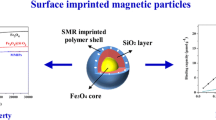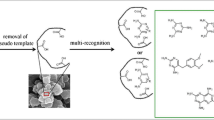Abstract
In this work, a facile route to prepare hydrophilic molecularly imprinted particles with magnetic susceptibility (MMIPs) was first reported via atom transfer radical precipitation polymerization (ATRPP) in a methanol/water solvent at low temperature (298 K), which can be considered as an environment-friendly system. During the process, 2-hydroxyethyl methacrylate and N, N-methylenebisacrylamide monomers were added to improve the hydrophilicity of the polymers. The obtained materials were characterized in detail by X-ray diffraction, transform infrared spectroscopy, thermogravimetric analysis, vibrating sample magnetometer, scanning electron microscopy and transmission electron microscopy, and then used for the selective separation of sulfamethazine (SMZ) from aqueous medium. The images showed Fe3O4 nanoparticles that were successfully embedded into the polymer particles with the size ranging from 450 to 650 nm, which exhibited great superparamagnetic susceptivity and high thermal stability. Batch adsorption experiments were performed to determine specific adsorption equilibrium, kinetics, and selective recognition and separation. The effect of the ratio of the double monomers used in the adsorption property was also studied. The equilibrium data of MMIPs toward SMZ was well fitted by the Langmuir isotherm model, and the maximum adsorption capacity estimated was 66.67 μmol g−1. The adsorption kinetics rapidly achieved equilibrium within 1.0 h and was well described by the pseudo-second-order model. The MMIPs synthesized showed outstanding affinity and selectivity toward SMZ over structurally analogous antibiotics and easily achieved magnetic separation under an external magnetic field. In addition, the adsorption performance of the resulting MMIPs was no obviously decreased at least six repeated cycles.












Similar content being viewed by others
References
Wulff G (2002) Enzyme-like catalysis by molecularly imprinted polymers. Chem Rev 102:1–27
Chen ZY, Xu L, Liang Y, Zhao MP (2010) PH-Sensitive water-soluble nanospheric imprinted hydrogels prepared as horseradish peroxidase mimetic enzymes. Adv Mater 22:1488–1492
Shen XT, Zhu LH, Li J, Tang HQ (2007) Synthesis of molecular imprinted polymer coated photocatalysts with high selectivity. Chem Commun 11:1163–1165
Matsui J, Sodeyama T, Saiki Y, Miyazawa T, Yamada T, Tamaki K, Murashima T (2009) Face-to-face porphyrin moieties assembled with spacing for pyrazine recognition in molecularly imprinted polymers. Biosens Bioelectron 25:635–639
Basabe-Desmonts L, Reinhoudt DN, Crego-Calama M (2007) Design of fluorescent materials for chemical sensing. Chem Soc Rev 36:993–1017
Mullett WM, Martin P, Pawliszyn J (2001) In-tube molecularly imprinted polymer solid-phase microextraction for the selective determination of propranolol. Anal Chem 73:2383–2389
Ariffin MM, Miller EI, Cormack PAG, Anderson RA (2007) Molecularly imprinted solid-phase extraction of diazepam and its metabolites from hair samples. Anal Chem 79:256–262
Yin JF, Yang GL, Chen Y (2005) Rapid and efficient chiral separation of nateglinide and its l-enantiomer on monolithic molecularly imprinted polymers. J Chromatogr A 1090:68–75
Zhang W, Qin L, He XW, Li WY, Zhang YK (2009) Novel surface modified molecularly imprinted polymer using acryloyl-β-cyclodextrin and acrylamide as monomers for selective recognition of lysozyme in aqueous solution. J Chromatogr A 1216:4560–4567
Beltran A, Borrull F, Marcé RM, Cormack PAG (2010) Molecularly-imprinted polymers: useful sorbents for selective extractions. TrAC Trends Anal Chem 29:1363–1375
Tamayo FG, Turiel E, Martín-Esteban A (2007) Molecularly imprinted polymers for solid-phase extraction and solid-phase microextraction: recent developments and future trends. J Chromatogr A 1152:32–40
Sellergren B (1994) Direct drug determination by selective sample enrichment on an imprinted polymer. Anal Chem 66:1578–1582
Pérez-Moral N, Mayes AG (2004) Comparative study of imprinted polymer particles prepared by different polymerization methods. Anal Chim Acta 504:15–21
Ye L, Mosbach K (2001) Molecularly imprinted microspheres as antibody binding mimics. React Funct Polym 48:149–157
Wang JF, Cormack PAG, Sherrington DC, Khoshdel E (2003) Monodisperse molecularly imprinted polymer microspheres prepared by precipitation polymerization for affinity separation applications. Angew Chem Int Ed 42:5336–5338
Chen LX, Xu SF, Li JH (2011) Recent advances in molecular imprinted technology: current status, challenges and highlighted applications. Chem Soc Rev 40:2922–2942
Zu BY, Pan GQ, Guo XZ, Zhang Y, Zhang HQ (2009) Preparation of molecularly imprinted polymer microspheres via atom transfer radical precipitation polymerization. J Polym Sci Part A Polym Chem 47:3257–3270
Matyjaszewski K, Xia J (2001) Atom transfer radical polymerization. Chem Rev 101:2921–2990
Zu BY, Pan GQ, Guo XZ, Zhang Y, Zhang HQ (2010) Preparation of molecularly imprinted polymers via atom transfer radical “bulk” polymerization. J Polym Sci Part A Polym Chem 48:532–541
Sasaki S, Ooya T, Takeuchi T (2010) Highly selective bisphenol A-imprinted polymers prepared by atom transfer radical polymerization. Polym Chem 1:1684–1688
Gai QQ, Qua F, Zhang T, Zhang YK (2011) The preparation of bovine serum albumin surface-imprinted superparamagnetic polymer with the assistance of basic functional monomer and its application for protein separation. J Chromatogr A 1218:3489–3495
Wei X, Husson SM (2005) Surface molecular imprinting by atom transfer radical polymerization. Biomacromolecules 6:1113–1121
Lu CH, Wang Y, Li Y, Yang HH, Chen X, Wang XR (2009) Bifunctional superparamagnetic surface molecularly imprinted polymer core-shell nanoparticles. J Mater Chem 19:1077–1079
Wei X, Husson SM (2007) Surface-grafted molecularly imprinted polymers grown from silica gel for chromatographic separations. Ind Eng Chem Res 46:2117–2124
Laurent S, Forge D, Port M, Roch A, Robic C, Elst LV, Muller RN (2008) Magnetic iron oxide nanoparticles: synthesis, stabilization, vectorization, physicochemical characterizations, and biological applications. Chem Rev 108:2064–2110
Arteaga KA, Rodriguez JA, Miranda JM, Medina J, Barrado E (2010) Determination of non-steroidal anti-inflammatory drugs in wastewaters by magnetic matrix solid phase dispersion-HPLC. Talanta 80:1152–1157
Zhang Y, Liu RJ, Hu YL, Li GK (2009) Microwave heating in preparation of magnetic molecularly imprinted polymer beads for trace triazines analysis in complicated samples. Anal Chem 81:967–976
Sarmah AK, Meyer MT, Boxall ABA (2006) A global perspective on the use, sales, exposure pathways, occurrence, fate and effects of veterinary antibiotics (VAs) in the environment. Chemosphere 65:725–759
Halling-Sørensen B, Nors-Nielsen S, Lanzky PF, Ingerslev F, Holten-Lützhøft HC, Jørgensen SE (1998) Occurrence, fate, and effects of pharmaceutical substances in the environment a review. Chemosphere 36:357–393
Martinez JL (2008) Antibiotics and antibiotic resistance genes in natural environments. Science 321:365–367
Hu YL, Li YW, Liu RJ, Tan W, Li GK (2011) Magnetic molecularly imprinted polymer beads prepared by microwave heating for selective enrichment of β-agonists in pork and pig liver samples. Talanta 84:462–470
Zheng N, Li YZ, Chang WB, Wang ZM, Li TJ (2002) Sulfonamide imprinted polymers using co-functional monomers. Anal Chim Acta 452:277–283
Matyjaszewski K (1999) Copper (I)-catalyzed atom transfer radical polymerization. Acc Chem Res 32:895–903
Robinson KL, Khan MA, de Paz Báňez MV, Wang XS, Armes SP (2001) Controlled polymerization of 2-hydroxyethyl methacrylate by aTRP at ambient temperature. Macromolecules 34:3155–3158
Wan WM, Pan CY (2007) Atom transfer radical dispersion polymerization in an ethanol/water mixture. Macromolecules 40:8897–8905
Du BY, Mei AX, Tao PJ, Zhao B, Cao Z, Nie JJ (2009) Poly[N-isopropylacrylaminde-co −3(trimethoxysilyl)-propylmethacrylate] coated aqueous dispersed thermosensitive Fe3O4 nanoparticle. J Phys Chem C 113:10090–10096
Yoshimatsu K, Reimhult K, Krozer A, Mosbach K, Sode K, Ye L (2007) Uniform molecularly imprinted microspheres and nanoparticles prepared by precipitation polymerization: the control of particle size suitable for different analytical applications. Anal Chim Acta 584:112–121
Langmuir I (1918) The adsorption of gases on plane surfaces of glass, mica and platinum. J Am Chem Soc 40:1361–1403
Umpleby RJ II, Baxter SC, Rampey AM, Rushton GT, Chen Y, Shimizu KD (2004) Characterization of the heterogeneous binding site affinity distributions in molecularly imprinted polymers. J Chromatogr B 804:141–149
Valtchev M, Palm BS, Schiller M, Steinfeld U (2009) Development of sulfamethoxazole-imprinted polymers for the selective extraction from waters. J Hazard Mater 170:722–728
Shi XZ, Meng Y, Liu JH, Sun AL, Li DX, Yao CX, Lu Y, Chen J (2011) Group-selective molecularly imprinted polymer solid-phase extraction for the simultaneous determination of six sulfonamides in aquaculture products. Journal of Chromatography B 879:1071–1076
Ho YS, McKay G (1999) The sorption of lead (II) ions on peat. Water Res 33:578–584
Ho YS, McKay G (1999) Pseudo-second order model for sorption processes. Process Biochem 34:451–465
Baydemir G, Andac M, Bereli N, Say R, Denizli A (2007) Selective removal of bilirubin from human plasma with bilirubin-imprinted particles. Ind Eng Chem Res 46:2843–2852
Acknowledgments
This work was financially supported by the National Natural Science Foundation of China (nos. 21077046, 21004031, 21176107, and 21174057), the National Basic Research Program of China (973 Program, 2012CB821500), Ph.D. Programs Foundation of Ministry of Education of China (no. 20110205110014), and Natural Science Foundation of Jiangsu Province (BK2011461).
Author information
Authors and Affiliations
Corresponding author
Rights and permissions
About this article
Cite this article
Zou, Y., Zhao, C., Dai, J. et al. Magnetic and hydrophilic imprinted particles via ATRP at room temperature for selective separation of sulfamethazine. Colloid Polym Sci 292, 333–342 (2014). https://doi.org/10.1007/s00396-013-3072-0
Received:
Revised:
Accepted:
Published:
Issue Date:
DOI: https://doi.org/10.1007/s00396-013-3072-0




